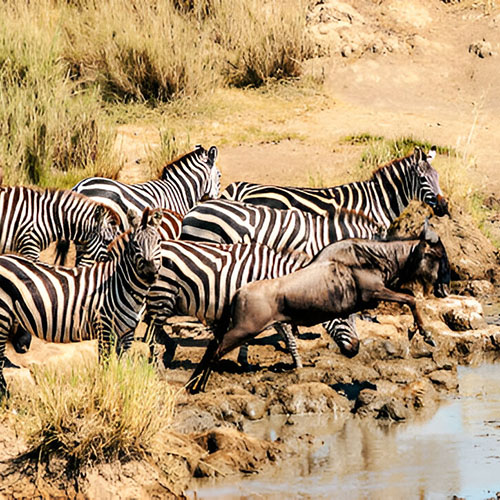Great Migration
Why Serengeti Great Migration?
The Wildebeest Great Migration is a spectacular annual movement of over two million wildebeest, accompanied by zebras and other game animals, migrating from Tanzania’s Serengeti National Park to Kenya’s Masai Mara National Reserve.
These animals embark on this journey in search of fresh grazing land and water, traveling across a distance of over 3,000 kilometers. The migration is dictated by seasonal changes and weather patterns, with herds moving from the north to the south, and vice versa, throughout the year. This natural phenomenon is one of the most thrilling wildlife events and a top bucket-list experience for safari lovers. What's So Special About It? What sets the Great Wildebeest Migration apart is that it's a year-round event, constantly evolving as herds follow a circular migration route through the Serengeti and Masai Mara. Each phase of the migration offers something unique, from dramatic river crossings to calving seasons where thousands of wildebeest give birth. A particularly awe-inspiring moment of the migration is the crossing of the Mara River, where wildebeests face swift currents, lurking crocodiles, and hippos. This is one of nature's most dramatic survival challenges, with predators waiting in anticipation. The event is not just about survival but is a complex display of the interdependence of species, as the wildebeests are often accompanied by zebras and closely followed by predators such as lions. The sheer scale of the migration, its danger, and the dramatic river crossings make it an unforgettable wildlife spectacle.
What too expect.
Photos of Serengeti Migration



Our Suggested Serengeti Migration Tours .

5 Days Wildebeest Migration Calving Safarii
5-Day Calving Safari: Witness the Thrilling Wildebeest Migration

10-Day Serengeti Wildebeest Migration Safari
The tour Adventure for breathtaking wildlife encounters!

14 Days Ultimate Tanzania Safari
Explore Serengeti, Ngorongoro, Tarangire, in an unforgettable adventure.
Why travel with
Genau Adventure Safaris.
Frequently Asked Questions
We've answered all your questions about African Big 5 Animals to help you plan the perfect trip.
The Big Five refers to five iconic African animals: the African lion, leopard, African elephant, rhinoceros (both black and white species), and Cape buffalo. These animals were originally termed “The Big Five” by game hunters due to their difficulty and danger in hunting them on foot.
The term "Big Five" was coined by 19th-century big game hunters who regarded these animals as the most dangerous to hunt on foot, not because of their size but due to the risk and difficulty of hunting them, especially when cornered or wounded.
The Big Five can be seen across several African countries, but Tanzania is one of the best destinations. The most popular locations to see the Big Five in Tanzania include:
- Serengeti National Park
- Ngorongoro Crater and Conservation Area
- Tarangire National Park
- Ruaha National Park
- Nyerere National Park
The dry season, from June to October, is the best time to see the Big Five in Tanzania. During this time, animals are easier to spot as they gather around water sources, and the vegetation is less dense, improving visibility.
Yes, the Serengeti National Park and Ngorongoro Crater in northern Tanzania offer some of the best chances to see all members of the Big Five in a single safari trip.
Some members of the Big Five, such as the black rhinoceros and white rhinoceros, are critically endangered due to poaching and habitat loss. Conservation efforts are in place to protect these species, but they remain under threat. The other Big Five animals—lions, leopards, elephants, and buffalo—are also at risk due to habitat loss, poaching, and human-wildlife conflict.
The main difference between black rhinos and white rhinos is their lip shape and feeding habits:
- Black rhinos have a pointed upper lip, which helps them browse on leaves and shrubs.
- White rhinos have a flat, wide lip suited for grazing on grass. In addition, white rhinos are larger and generally more docile than their black rhino counterparts.
While on safari, you'll typically observe the Big Five from the safety of a safari vehicle. The distance between you and the animals will depend on their behavior, the terrain, and safety regulations. However, in certain game reserves or conservancies, walking safaris with experienced guides allow for closer, yet safe, encounters.
No, it is not dangerous to observe the Big Five as long as you follow the guidance of your safari guide. Safari operators prioritize the safety of their guests, and animals typically keep their distance unless provoked. Always respect wildlife and maintain a safe distance, particularly with unpredictable animals like buffalo and elephants.
For a Big Five safari, pack essentials such as:
- Binoculars for better viewing
- A good camera for capturing wildlife
- Comfortable, neutral-colored clothing for blending into the environment
- Sun protection, including sunscreen, a hat, and sunglasses
- Insect repellent to guard against bites
- Water and snacks to stay hydrated during game drives





